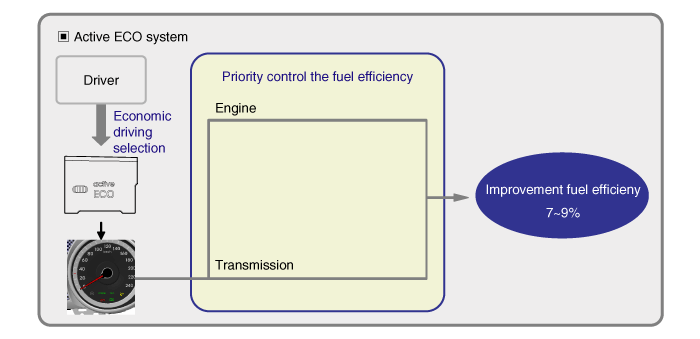 Hyundai Veloster: Instrument Cluster. Description and Operation
Hyundai Veloster 2011-2017 Service Manual / Body Electrical System / Indicators And Gauges / Instrument Cluster. Description and Operation
Hyundai Veloster: Instrument Cluster. Description and Operation
Hyundai Veloster 2011-2017 Service Manual / Body Electrical System / Indicators And Gauges / Instrument Cluster. Description and Operation
Hyundai Veloster 2011-2017 Service Manual / Body Electrical System / Indicators And Gauges / Instrument Cluster. Description and Operation
Active ECO System
| 1. |
Active ECO System
While the general eco system encourages the driver to drive efficiently
by displaying ECO lights on the dashboard, the active ECO system controls
the transmission forcibly to achieve fuel efficiency. The driver can
activate the active ECO button on the steering wheel to engage this
mode. If the active ECO is selected, then the engine and transmission
are controlled with priority placed on fuel efficiency. It achieves
even greater fuel economy than the conventional system. The active ECO
system may not engage under certain conditions. (e.g., when driving
up an incline or before the engine is warmed up). If active ECO is not
selected, then the general ECO System can be selected and engaged.
|
| 2. |
Active ECO Features
|
| 3. |
Conditions That Prevent Active ECO System Engagement
|
 Instrument Cluster. Repair procedures
Instrument Cluster. Repair procedures
Inspection
Speedometer
1.
Adjust the pressure of the tires to the specified level.
2.
Drive the vehicle onto a speedometer tester. Use whee ...
 Troubleshooting
Troubleshooting
Troubleshooting
Symptom
Possible cause
Remedy
Tachometer does not operate
Cluster fuse (10A) blown
Check for short and repl ...
See also:
Components and Components Location
Component Location
1. IPM
2. Ultrasonic sensor
3. Rear parking assist switch (OFF)
※ The IPM contains the rear parking assist system ...
Side Airbag (SAB) Module. Repair procedures
Removal
The side airbag cannot be disassembled from the seat back assembly,
so replace assembly when replacing the side airba ...
Hill-start assist control (HAC)
A vehicle has the tendency to slip back on a steep hill when the driver begins
to accelerate after a stop. The Hill-start Assist Control (HAC) prevents the vehicle
from slipping back by operating ...
Categories
- Hyundai Veloster Manuals Home
- Hyundai Veloster 2010-2017 Owner's Manual
- Hyundai Veloster 2010-2017 Service Manual
В© 2011-2025 Copyright www.hvmanual.com

